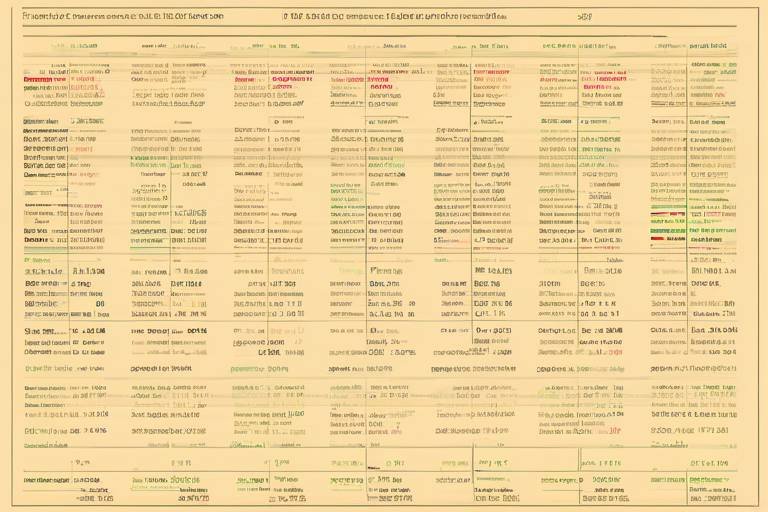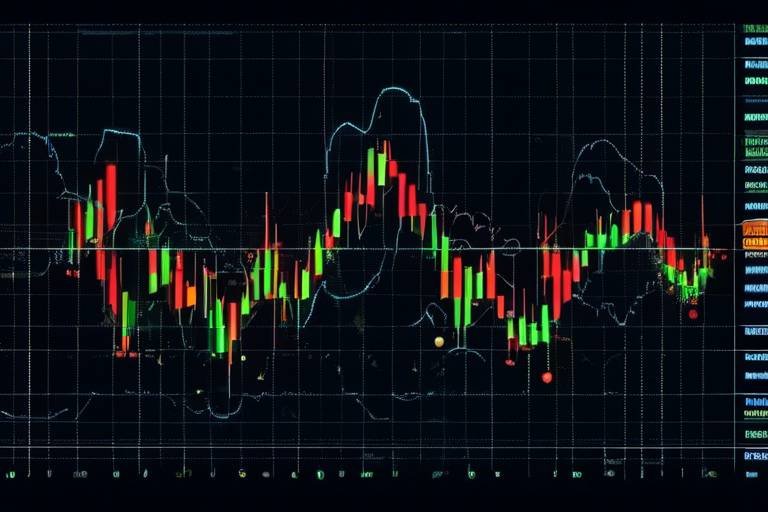How to Use Technical Analysis to Minimize Trading Risks
In the world of trading, **risk management** is not just a strategy; it's a necessity. Every trader, whether a seasoned pro or a novice, knows that the market can be unpredictable. This is where technical analysis comes into play. By studying past market data, particularly price and volume, traders can forecast future price movements and make informed decisions. Imagine having a crystal ball that helps you navigate the often turbulent waters of trading—this is precisely what technical analysis aims to provide.
So, how does one leverage technical analysis to minimize risks? It all starts with understanding the **principles** behind it. Technical analysis is more than just looking at charts; it's about recognizing patterns and trends that can inform your trading strategy. For instance, by identifying whether a market is in an uptrend or downtrend, traders can position themselves favorably to either capitalize on gains or protect against losses. But it’s not just about recognizing trends; it’s also about using various tools effectively to enhance your analysis.
Traders utilize an arsenal of tools, including various chart types and indicators, to dissect market behavior. Each tool serves a unique purpose, providing insights that can significantly impact trading decisions. Whether you prefer the simplicity of a line chart or the detailed candlestick chart, understanding how to interpret these visuals is crucial. For example, candlestick charts offer a **detailed look** at price action within specific time frames, giving traders a glimpse into market sentiment. This detailed information can be pivotal when identifying potential reversals or continuations in the market.
Moreover, technical indicators like moving averages and the Relative Strength Index (RSI) play a crucial role in enhancing your trading strategy. These indicators not only help signal potential entry and exit points but also assist in fine-tuning your risk management approach. By incorporating these tools into your trading routine, you're not just making educated guesses; you're making data-driven decisions that can lead to greater profitability.
But understanding technical analysis is just the tip of the iceberg. To truly minimize trading risks, one must also grasp the concepts of **support and resistance levels**. These levels are critical in determining where price may reverse or continue its trend. Support levels are where buying interest tends to emerge, potentially halting a downtrend, while resistance levels signify selling pressure that can cap an uptrend. Knowing these levels allows traders to set more effective stop-loss orders, thereby minimizing potential losses and maximizing gains.
Incorporating effective risk management strategies is essential for any trader aiming to succeed in the market. Techniques such as position sizing, diversification, and setting stop-loss orders can significantly enhance your trading performance. Position sizing involves determining how much capital to allocate to a trade, ensuring that you don’t overextend yourself. Diversification, on the other hand, spreads your investments across various assets, reducing the impact of a poor-performing asset on your overall portfolio. These strategies, when combined with technical analysis, create a robust framework for navigating the complexities of trading.
Finally, let’s not overlook the importance of backtesting your strategies. By evaluating past performance using historical data, traders can identify strengths and weaknesses in their approach. A well-structured backtesting plan outlines the parameters for evaluating a trading strategy, ensuring that you can systematically assess performance. Analyzing backtesting results provides invaluable insights, helping you refine your strategy and make more informed trading decisions moving forward.
- What is technical analysis? Technical analysis is the study of past market data, primarily price and volume, to forecast future price movements.
- How can technical analysis minimize risks? By identifying trends, support and resistance levels, and using indicators, traders can make more informed decisions, reducing potential losses.
- What are support and resistance levels? Support levels are price points where buying interest increases, while resistance levels are where selling pressure emerges, both critical for risk management.
- Why is backtesting important? Backtesting allows traders to evaluate the effectiveness of their strategies using historical data, helping to identify profitable patterns and areas for improvement.

Understanding Technical Analysis
Technical analysis is a powerful tool that traders use to make sense of the chaotic world of financial markets. At its core, it involves evaluating past market data, primarily focusing on price and volume, to forecast future price movements. Think of it as a detective trying to solve a mystery; by examining the clues left behind in the form of price charts and trading volumes, traders can uncover patterns and trends that may indicate where the market is headed next.
One of the key principles of technical analysis is that price movements are not random. They often follow certain patterns due to market psychology, which is influenced by various factors such as news events, economic indicators, and trader sentiment. By understanding these patterns, traders can make more informed decisions, potentially increasing their chances of success in the market.
Technical analysis is not just about looking at price charts; it also involves using a variety of tools and techniques to analyze market behavior. Among these tools are charts, indicators, and oscillators. Each of these components plays a crucial role in helping traders identify potential risks and opportunities.
For instance, traders often rely on different types of charts to visualize price movements. Here’s a quick overview of some common chart types:
| Chart Type | Description |
|---|---|
| Line Chart | Simplifies price movements by connecting closing prices over time, ideal for spotting long-term trends. |
| Bar Chart | Displays open, high, low, and close prices for a specific period, providing a more detailed view of price action. |
| Candlestick Chart | Offers intricate details about price action, showing market sentiment and potential reversals within specific time frames. |
In addition to charts, traders use various technical indicators to assist in their decision-making process. These indicators can signal potential entry and exit points, enhancing risk management strategies. For example, moving averages help smooth out price data to identify trends, while the Relative Strength Index (RSI) indicates whether a market is overbought or oversold.
Ultimately, understanding technical analysis is about connecting the dots between price movements and market psychology. By leveraging the tools and techniques available, traders can navigate the complexities of the market with greater confidence, making informed decisions that align with their trading goals.

Key Tools in Technical Analysis
When diving into the world of trading, understanding the key tools of technical analysis is like having a compass in uncharted waters. These tools help traders navigate the often turbulent market landscape by providing insights into price movements and market sentiment. Among the most essential tools are charts, indicators, and oscillators. Each plays a unique role in the trading strategy, and mastering them can significantly enhance a trader's ability to make informed decisions.
Charts are the backbone of technical analysis. They visually represent market data, allowing traders to quickly identify trends and patterns. There are several types of charts, each offering different perspectives:
- Line Charts: These charts provide a simple view of price movements by connecting closing prices over a specified time period. They are excellent for spotting long-term trends but may overlook short-term volatility.
- Candlestick Charts: These are more complex and provide a wealth of information. Each candlestick displays the open, high, low, and close prices for a specific period, helping traders gauge market sentiment and identify potential reversals.
- Bar Charts: Similar to candlestick charts, bar charts show open, high, low, and close prices but in a different visual format. They can be useful for traders who prefer a more straightforward representation of price action.
Moving beyond charts, we encounter technical indicators. These mathematical calculations based on price and volume data help traders identify potential entry and exit points. Some popular indicators include:
- Moving Averages: These indicators smooth out price data to identify trends over a certain period. They can help traders determine whether to buy or sell based on the direction of the average.
- Relative Strength Index (RSI): This momentum oscillator measures the speed and change of price movements, helping traders identify overbought or oversold conditions in the market.
Additionally, oscillators are another critical component of technical analysis. These tools fluctuate within a certain range and are particularly useful in sideways markets. They help traders identify potential reversals by indicating whether an asset is overbought or oversold. Examples include the Stochastic Oscillator and the MACD (Moving Average Convergence Divergence).
In summary, the tools of technical analysis are indispensable for traders looking to minimize risks and enhance their trading strategies. By effectively utilizing charts, indicators, and oscillators, traders can gain a clearer understanding of market dynamics, enabling them to make more informed decisions and ultimately improve their trading performance.
- What is technical analysis? Technical analysis involves evaluating past market data, primarily price and volume, to forecast future price movements.
- Why are charts important in technical analysis? Charts visually represent price movements, helping traders identify trends and patterns quickly.
- What are technical indicators? Technical indicators are mathematical calculations based on price and volume data that assist traders in making data-driven decisions.
- How do I choose the right tools for my trading strategy? The right tools depend on your trading style, market conditions, and specific goals. It's essential to experiment with different tools to find what works best for you.

Chart Types
When it comes to technical analysis, understanding the different is crucial for any trader. These charts serve as the visual representation of price movements over time, and each type offers unique insights that can dramatically affect your trading decisions. Think of charts as the canvas on which the market paints its story; each stroke reveals trends, reversals, and potential opportunities. The three primary chart types you'll encounter are line charts, bar charts, and candlestick charts. Let's dive deeper into each type and see how they can enhance your trading strategy.
Line charts are the simplest form of charting, connecting closing prices over a specified time frame. Imagine a smooth line that flows like a river, reflecting the overall trend of the market. They are particularly effective for identifying long-term trends, but they can sometimes overlook short-term fluctuations. This makes them ideal for traders who focus on the bigger picture rather than the minutiae of daily price movements.
On the other hand, candlestick charts provide a more detailed view of price action. Each candlestick represents four key price points: the open, high, low, and close. This rich information allows traders to visualize market sentiment at a glance. For instance, a series of green candles may indicate strong buying pressure, while red candles could suggest increasing selling pressure. The patterns formed by these candlesticks can also signal potential reversals or continuations, making them invaluable for traders looking to time their entries and exits effectively.
Lastly, bar charts offer a middle ground between line and candlestick charts. Each bar represents the same four price points as a candlestick but displays them differently. The vertical line shows the range between the high and low prices, while the small horizontal lines on the left and right indicate the opening and closing prices. This format allows traders to quickly assess price movements and volatility, making it easier to spot potential trading opportunities.
In summary, understanding these chart types is essential for anyone looking to leverage technical analysis effectively. Whether you prefer the simplicity of line charts, the detailed insights of candlestick charts, or the balanced approach of bar charts, each has its strengths and can be used to identify market trends and reversals. By mastering these tools, you can enhance your trading strategies and minimize risks.
- What is the best chart type for beginners?
For beginners, line charts are often recommended as they provide a clear view of overall trends without overwhelming details.
- How can I use candlestick patterns in my trading?
Candlestick patterns can help you identify potential reversals or continuations. Learning common patterns like dojis, hammers, and engulfing can significantly enhance your trading strategy.
- Can I use multiple chart types simultaneously?
Absolutely! Many traders use a combination of chart types to gain different perspectives on the market. For example, they might use a line chart for a macro view and candlestick charts for precise entry and exit points.

Line Charts
Line charts are a fundamental tool in the arsenal of any trader looking to grasp the essence of market trends at a glance. By connecting closing prices over a specified time frame, line charts create a visual representation that simplifies the often chaotic world of trading. Imagine you’re trying to decipher a complex puzzle; line charts help you piece together the bigger picture by stripping away the noise and focusing solely on the price movements that matter.
One of the key advantages of line charts is their ability to highlight long-term trends. This makes them particularly useful for traders who are looking to make informed decisions based on broader market movements rather than getting lost in the day-to-day fluctuations. However, while they excel in showcasing the overall trend, it’s important to acknowledge that line charts may not capture short-term price changes effectively. Think of them as the macro lens of a camera, providing a clear view of the landscape but potentially missing the fine details of individual flowers blooming along the way.
Additionally, line charts can be utilized in conjunction with other technical analysis tools to enhance trading strategies. For instance, traders often overlay moving averages on line charts to identify potential buy or sell signals. By observing where the price line intersects with the moving average, traders can make more informed decisions. Here’s a simple breakdown of how line charts can be integrated with other tools:
- Trend Identification: Use line charts to spot upward or downward trends.
- Signal Generation: Combine with moving averages for entry and exit points.
- Support and Resistance: Identify key levels where price tends to bounce or reverse.
In summary, while line charts may seem basic, their simplicity is their strength. They provide traders with a clear and concise view of price movements over time, making them an invaluable resource for anyone looking to minimize trading risks. Whether you’re a seasoned trader or just starting out, incorporating line charts into your technical analysis toolkit can significantly enhance your understanding of market dynamics.
What is a line chart?
A line chart is a graphical representation of data points connected by straight lines, primarily used to display price movements over time.
How do I read a line chart?
To read a line chart, look at the x-axis (time) and y-axis (price) to see how the price has changed over the specified time period.
Can line charts predict future prices?
While line charts can help identify trends, they cannot predict future prices with certainty. They are best used in conjunction with other analysis tools.
Are line charts suitable for day trading?
Line charts are more beneficial for identifying longer-term trends. Day traders may prefer candlestick charts for more detailed price action analysis.

Candlestick Charts
Candlestick charts are a vital tool in the world of technical analysis, providing traders with a detailed view of price movements over specific time frames. Each individual candlestick conveys a wealth of information, encapsulating four critical data points: the open, high, low, and close prices within that period. This rich visual representation allows traders to gauge market sentiment and identify potential reversals with remarkable accuracy.
What makes candlestick charts particularly powerful is their ability to showcase the relationship between buyers and sellers. For instance, a candlestick that closes higher than it opens indicates bullish sentiment, suggesting that buyers have taken control. Conversely, if a candlestick closes lower than it opens, it reflects bearish sentiment, hinting at increased selling pressure. This duality can be likened to a tug-of-war between bulls and bears, with each candlestick telling the story of who is winning at that moment.
Moreover, candlestick patterns can reveal critical insights about future price movements. Traders often look for specific formations, such as:
- Doji: A candlestick with a very small body, indicating indecision in the market.
- Hammer: A bullish reversal pattern that occurs after a downtrend, characterized by a small body and a long lower shadow.
- Engulfing Pattern: A two-candle formation where the second candle completely engulfs the first, signaling a potential reversal.
By analyzing these patterns, traders can make more informed decisions about when to enter or exit trades. For example, spotting a hammer after a downtrend may prompt a trader to consider a buying opportunity, while recognizing an engulfing pattern during an uptrend could signal a potential sell-off.
In conclusion, mastering candlestick charts is essential for any trader looking to refine their technical analysis skills. By understanding how to interpret the information provided by each candlestick, traders can gain a deeper insight into market dynamics and improve their chances of making profitable trades.
- What is a candlestick chart?
A candlestick chart is a type of financial chart that displays the price movements of an asset over time, using individual candlesticks to represent open, high, low, and close prices. - How do I read candlestick patterns?
To read candlestick patterns, look at the body and wicks of each candlestick. The body shows the open and close prices, while the wicks indicate the high and low prices. Patterns can suggest bullish or bearish trends. - What are some common candlestick patterns?
Common candlestick patterns include the Doji, Hammer, and Engulfing patterns, each indicating potential market reversals or continuations.

Technical Indicators
When it comes to navigating the often turbulent waters of trading, serve as your compass, guiding you through the chaos of market movements. These mathematical calculations, based on historical price and volume data, are crucial for traders looking to make informed decisions. By utilizing these indicators, traders can identify potential entry and exit points, as well as gauge market momentum. But what exactly are these indicators, and how can you leverage them effectively in your trading strategy?
There are several types of technical indicators, each serving a unique purpose. For example, moving averages smooth out price data to help traders identify trends over a specific period. By calculating the average price over a defined number of periods, moving averages can signal whether a market is trending upwards or downwards. On the other hand, the Relative Strength Index (RSI) measures the speed and change of price movements, helping traders determine whether a market is overbought or oversold. Understanding these indicators allows traders to enhance their risk management strategies significantly.
To illustrate the effectiveness of these indicators, let’s take a closer look at a few popular ones:
| Indicator | Purpose | How to Use |
|---|---|---|
| Moving Average | Identifies the trend direction | Buy when the price crosses above the moving average; sell when it crosses below |
| Relative Strength Index (RSI) | Measures market momentum | Look for overbought (>70) or oversold (<30) conditions to make trading decisions |
| Bollinger Bands | Indicates volatility and potential price reversals | Consider buying when the price touches the lower band and selling when it hits the upper band |
By combining different indicators, traders can develop a more comprehensive view of the market. For instance, using a moving average in conjunction with the RSI can provide a clearer picture of whether a trend is likely to continue or reverse. Think of it as piecing together a puzzle; each indicator offers a unique piece that contributes to the overall picture of market behavior.
However, it's essential to remember that no single indicator is foolproof. Relying solely on one indicator can lead to misleading signals. Instead, traders should adopt a holistic approach, integrating multiple indicators while also considering external factors such as news events and market sentiment. This multifaceted strategy not only enhances decision-making but also helps in effectively minimizing risks.
In conclusion, mastering technical indicators is a vital skill for any trader looking to navigate the complexities of the market. By understanding how to interpret these tools and incorporating them into your trading strategy, you can significantly improve your chances of making informed, data-driven decisions. So, are you ready to put these indicators to work and enhance your trading game?
- What are technical indicators?
Technical indicators are mathematical calculations based on historical price and volume data used to forecast future price movements. - How do I choose the right indicators?
Consider your trading style and strategy. Some traders prefer trend-following indicators, while others might focus on momentum indicators. - Can I rely solely on technical indicators for trading decisions?
No, it's best to use a combination of indicators along with fundamental analysis and market sentiment to make well-rounded trading decisions.

Identifying Support and Resistance Levels
In the world of trading, understanding support and resistance levels is like having a map in a dense forest. These levels act as crucial indicators that help traders navigate potential price reversals and make informed decisions. Support levels are essentially price points where a downward trend tends to pause, primarily due to an increase in buying interest. Imagine a safety net; when prices drop to these levels, traders often step in to buy, believing that the price will bounce back. Recognizing these levels can significantly enhance your risk management strategies, allowing you to set stop-loss orders more effectively and minimize potential losses.
On the flip side, resistance levels represent points where an upward trend may stall due to selling pressure. Think of it like a ceiling that prices struggle to break through. When prices reach these levels, sellers often emerge, believing that the price is too high and that it’s time to cash in on their profits. By identifying these resistance points, traders can anticipate potential reversals, adjust their strategies, and avoid getting caught in a market downturn.
To illustrate this concept, consider the following table that summarizes the key differences between support and resistance levels:
| Aspect | Support Levels | Resistance Levels |
|---|---|---|
| Definition | Price points where a downtrend can pause due to increased buying interest. | Price points where an uptrend may stall due to selling pressure. |
| Market Behavior | Buyers enter the market, preventing prices from falling further. | Sellers enter the market, preventing prices from rising further. |
| Trading Strategy | Traders often set stop-loss orders below support levels. | Traders often set stop-loss orders above resistance levels. |
Identifying these levels isn't just about drawing lines on a chart; it requires a keen understanding of market psychology and the dynamics of supply and demand. As a trader, you can look at historical price action to pinpoint where these levels have formed in the past. One effective method is to use trend lines or horizontal lines that connect multiple price points over time. The more times a price level has been tested, the stronger the support or resistance is likely to be.
Moreover, the significance of these levels can change over time. For instance, when a resistance level is broken, it can transform into a support level, and vice versa. This dynamic nature of support and resistance highlights the importance of continuous market analysis. By staying vigilant and adapting to market changes, traders can position themselves more effectively and minimize risks.
In summary, mastering the identification of support and resistance levels is a fundamental skill for any trader. It not only aids in making better trading decisions but also enhances risk management strategies. So, the next time you analyze a chart, remember to look for these critical levels—they could be the key to unlocking your trading potential!
- What are support and resistance levels? Support levels are price points where a downtrend pauses due to buying interest, while resistance levels are where an uptrend may stall due to selling pressure.
- How do I identify support and resistance levels? You can identify these levels by analyzing historical price action and looking for price points that have been tested multiple times.
- Can support and resistance levels change? Yes, when a resistance level is broken, it can turn into a support level and vice versa, reflecting the dynamic nature of the market.

Support Levels
Support levels are like safety nets in the unpredictable world of trading. They represent price points where a downtrend can pause or reverse due to increased buying interest. Think of it as the floor in a building; just as the floor supports the structure above, support levels provide a cushion for prices, preventing them from falling further. When traders identify these levels, they can make more informed decisions about when to enter or exit a trade, effectively minimizing their risks.
Understanding how to spot support levels is crucial for any trader looking to enhance their trading strategy. These levels can be identified through various methods, including historical price data, trend lines, and moving averages. For instance, if a stock has previously bounced back from a certain price point multiple times, that price point may be considered a strong support level. This repetition creates a psychological barrier for traders, leading to increased buying pressure as prices approach that level again.
Here’s a quick rundown of how support levels can be effectively utilized in trading:
- Setting Stop-Loss Orders: Traders can place stop-loss orders just below identified support levels to protect against significant losses. If the price breaks through this level, it may indicate a stronger downtrend, prompting traders to exit their positions.
- Planning Entry Points: When prices approach a support level, it could be an opportune moment to enter a long position, anticipating a bounce back. This strategy allows traders to buy at lower prices with the expectation of future gains.
- Assessing Market Sentiment: A strong support level often reflects bullish sentiment among traders. If prices consistently bounce off this level, it indicates that buyers are willing to step in, which can boost confidence in the trade.
However, it's important to remember that support levels are not foolproof. They can be broken, leading to what is known as a "breakdown." When this happens, the previous support level may become a new resistance level, causing traders to reevaluate their strategies. This phenomenon highlights the necessity of continuous market analysis and adaptability in trading approaches.
In summary, recognizing and understanding support levels is a fundamental aspect of technical analysis that can significantly reduce trading risks. By effectively utilizing these levels, traders can make more informed decisions, set strategic stop-loss orders, and identify potential entry points. The key is to remain vigilant and responsive to market changes, ensuring that you adapt your strategies as needed to safeguard your investments.
- What is a support level? A support level is a price point where a stock or asset tends to stop falling and may even bounce back due to increased buying interest.
- How can I identify support levels? You can identify support levels by analyzing historical price data, using trend lines, and applying technical indicators like moving averages.
- What should I do if a support level is broken? If a support level is broken, it may indicate a stronger downtrend. Traders often reassess their positions and may consider exiting trades or setting new stop-loss orders.

Resistance Levels
Resistance levels are critical price points on a chart where an asset's price tends to struggle to rise above. Think of resistance as an invisible ceiling that traders are trying to break through. When the price approaches this level, selling pressure often increases, leading to a potential reversal in the trend. This phenomenon occurs because traders who bought at lower prices may decide to take profits, resulting in a surge of selling activity that can push the price back down.
Understanding resistance levels is essential for traders looking to make informed decisions. By identifying these levels, traders can set appropriate entry and exit points, enhancing their overall risk management strategies. For instance, if a trader recognizes a strong resistance level, they might choose to wait for the price to break above it before entering a long position. Alternatively, if the price hits a resistance level and shows signs of reversal, it could be an excellent opportunity to sell or short the asset.
Resistance levels can be identified through various methods, including:
- Historical Price Action: Looking at past price movements can reveal where the price has struggled to rise previously.
- Technical Indicators: Tools like moving averages can act as dynamic resistance levels, adjusting as prices change.
- Trend Lines: Drawing trend lines can help visualize potential resistance points based on the angle of previous price movements.
It’s important to note that resistance levels are not set in stone. They can be broken, leading to new highs, which can create a shift in market sentiment. Once a resistance level is breached, it may transform into a support level, where the price finds buying interest on a pullback. This dynamic nature of resistance levels highlights the importance of continuously monitoring market conditions and adapting trading strategies accordingly.
In summary, resistance levels serve as crucial indicators for traders. By understanding where these levels lie and how they can influence price movements, traders can make more informed decisions, ultimately minimizing their trading risks.
What are resistance levels?
Resistance levels are price points where an asset tends to face selling pressure, making it difficult for the price to rise above that level.
How can I identify resistance levels?
Resistance levels can be identified through historical price action, technical indicators, and trend lines.
What happens when a resistance level is broken?
When a resistance level is broken, it may indicate a strong bullish sentiment, and the previous resistance could become a new support level.
Why are resistance levels important in trading?
Resistance levels help traders set entry and exit points, manage risk, and understand potential price reversals.

Risk Management Strategies
When it comes to trading, the thrill of potential profits can sometimes overshadow the importance of protecting your capital. This is where come into play. Think of risk management as your safety net; it’s there to catch you when the markets take an unexpected turn. Without it, even the most promising trades can lead to devastating losses. So, let’s dive into some effective strategies that can help you minimize risks while maximizing your trading potential.
One of the cornerstone techniques in risk management is position sizing. This refers to determining how much of your total capital to allocate to a single trade. Imagine you're at a casino; would you bet your entire bankroll on one hand of blackjack? Probably not! Similarly, in trading, proper position sizing ensures that you’re not risking too much on any one trade. A common rule of thumb is to risk no more than 1-2% of your trading capital on a single trade. This way, even a series of losses won’t wipe you out.
Another critical strategy is diversification. Just as you wouldn’t put all your eggs in one basket, diversifying your investments across different assets can significantly reduce risk. For instance, if you invest in stocks, bonds, and commodities, a downturn in one market may be offset by gains in another. This balance can provide a cushion against volatility, allowing you to weather the storm when the markets get choppy.
Setting stop-loss orders is also a fundamental aspect of risk management. A stop-loss order is like a safety switch; it automatically sells your asset when it reaches a certain price, limiting your losses. By establishing these orders, you can take the emotion out of trading decisions. Imagine you’ve invested in a stock that starts to plummet. Without a stop-loss in place, panic might lead you to hold on too long, hoping for a rebound. However, with a stop-loss, you can exit the trade before the losses become unmanageable.
To illustrate how effective these strategies can be, consider the following table that outlines the impact of different risk management techniques on a hypothetical trading scenario:
| Strategy | Risk per Trade (%) | Potential Loss After 5 Losses |
|---|---|---|
| Without Risk Management | 100% | 100% (Total Loss) |
| 1% Risk Management | 1% | 5% (Still Trading) |
| 2% Risk Management | 2% | 10% (Still Trading) |
This table shows how implementing even a basic risk management strategy can keep you in the game longer, allowing for recovery and future opportunities. Remember, the goal is not just to survive but to thrive in the trading environment.
Ultimately, having a solid risk management plan in place can be the difference between a successful trading career and a series of unfortunate losses. By focusing on position sizing, diversification, and stop-loss orders, you can create a robust framework that not only protects your capital but also enhances your trading performance.
- What is risk management in trading? Risk management in trading refers to the strategies and techniques used to minimize potential losses while maximizing profits.
- How much of my capital should I risk on a single trade? It’s generally advised to risk no more than 1-2% of your total trading capital on any single trade.
- What are stop-loss orders? Stop-loss orders are instructions to sell an asset when it reaches a predetermined price, helping to limit losses.
- How does diversification help in trading? Diversification spreads your investments across different assets, reducing the impact of poor performance in any single asset.

Position Sizing
Position sizing is a fundamental concept in trading that refers to the amount of capital a trader allocates to a specific trade. It’s akin to a chef deciding how much of each ingredient to use in a recipe; too much of one thing can spoil the dish, just as too large a position can lead to significant losses. By determining the right position size, traders can effectively manage their risk and ensure that their trading strategies are sustainable over the long term.
One of the key aspects of position sizing is understanding the concept of risk tolerance. Each trader has a different level of comfort when it comes to potential losses, which can be influenced by factors such as account size, trading experience, and market conditions. A common rule of thumb is to risk no more than 1-2% of your trading capital on a single trade. For example, if you have a trading account of $10,000, risking 2% means you would only risk $200 on any single trade. This approach helps to protect your capital while allowing for consistent growth over time.
To effectively determine position size, traders often use the following formula:
| Formula | Description |
|---|---|
| Position Size (Account Risk x Account Size) / Trade Risk | This formula helps calculate how many units of an asset to trade based on the amount you are willing to risk and the risk per trade. |
Let’s break this down further:
- Account Risk: This is the percentage of your total account that you are willing to risk on a trade. As mentioned earlier, this is typically set between 1-2%.
- Account Size: This is the total amount of capital in your trading account.
- Trade Risk: This refers to the difference between your entry price and your stop-loss price. It’s the amount you stand to lose if the trade goes against you.
By using this formula, traders can make informed decisions about how much to invest in each trade, thereby minimizing their exposure to risk. Additionally, position sizing can be adjusted based on the volatility of the asset being traded. For example, if you’re trading a highly volatile stock, you may want to reduce your position size to account for the increased risk of large price swings. Conversely, with a more stable asset, you might feel comfortable increasing your position size.
In summary, position sizing is not just about determining how much to invest; it’s a crucial part of a comprehensive risk management strategy. By carefully considering your risk tolerance, utilizing the position size formula, and adjusting for market conditions, you can enhance your trading performance and protect your capital from unexpected market movements. Remember, in trading, it’s not just about how much you can gain, but how much you can afford to lose.
Q1: What is the best percentage to risk per trade?
A1: Many traders recommend risking between 1-2% of your account balance per trade. This helps manage risk effectively while allowing for potential growth.
Q2: How can I calculate my trade risk?
A2: Trade risk is calculated by determining the difference between your entry price and your stop-loss price. This amount represents what you stand to lose if the trade does not go in your favor.
Q3: Can position sizing change over time?
A3: Yes, position sizing can change based on your trading experience, account size, and market conditions. It’s important to regularly reassess your risk tolerance and adjust your position sizes accordingly.

Diversification
is a fundamental strategy that traders and investors use to spread risk across various assets. Think of it like not putting all your eggs in one basket; if that basket falls, you don't want to lose everything. By diversifying your investments, you can reduce the impact of a poor-performing asset on your overall portfolio. This strategy is particularly important in volatile markets where prices can fluctuate dramatically.
When you diversify, you're essentially creating a safety net. For instance, if you invest in a mix of stocks, bonds, and commodities, the poor performance of one asset class might be offset by the stability or growth of another. It's a way to smooth out the bumps in your investment journey. Imagine you're a farmer; if you only plant one crop and a blight hits, your entire yield is at risk. However, if you plant multiple crops, even if one fails, others may thrive.
Here are some key benefits of diversification:
- Risk Reduction: By holding a variety of investments, you can minimize the impact of a single asset's poor performance.
- Improved Returns: Diversification can enhance your chances of achieving more stable returns over time.
- Market Exposure: It allows you to gain exposure to different sectors and markets, which can be beneficial during different economic cycles.
However, it's essential to note that diversification doesn't guarantee profits or protect against losses. The goal is to find the right balance that aligns with your risk tolerance and investment goals. A well-diversified portfolio might include:
| Asset Class | Example Investments |
|---|---|
| Stocks | Technology, Healthcare, Consumer Goods |
| Bonds | Government Bonds, Corporate Bonds |
| Commodities | Gold, Silver, Oil |
| Real Estate | REITs, Rental Properties |
In conclusion, diversification is a crucial element of a robust trading strategy. It allows traders to navigate through unpredictable markets with a sense of security. By spreading investments across different asset classes, you can better manage risk and potentially enhance your overall returns. Just remember, while diversification can be a powerful tool, it’s essential to regularly review and adjust your portfolio to ensure it meets your financial goals.
Q1: What is diversification?
A1: Diversification is the practice of spreading investments across various asset classes to reduce risk. This way, poor performance in one area may be offset by better performance in another.
Q2: Does diversification guarantee profits?
A2: No, while diversification can help minimize risk, it does not guarantee profits or protect against losses. It is a strategy to manage risk more effectively.
Q3: How many assets should I have in a diversified portfolio?
A3: There is no one-size-fits-all answer, but a mix of different asset classes and sectors is generally recommended. It's important to find a balance that aligns with your risk tolerance and investment goals.

Backtesting Strategies
Backtesting is an essential practice for traders who want to refine their technical analysis strategies and enhance their decision-making process. By utilizing historical data to evaluate how a particular trading strategy would have performed in the past, traders can gain invaluable insights into its potential effectiveness. Imagine trying to navigate a vast ocean without a map; backtesting serves as that crucial map, guiding traders through the unpredictable waters of the market. It allows them to identify strengths, weaknesses, and areas for improvement in their approaches.
When embarking on the backtesting journey, it is vital to create a structured plan. This plan should outline specific parameters and criteria for evaluating the trading strategy. For instance, a trader might decide to test a strategy over a particular time frame, using specific market conditions and asset classes. This structured approach ensures that the assessment is systematic and data-driven, rather than based on gut feelings or random observations.
Once the backtesting plan is in place, the next step involves analyzing the results. This analysis is where the magic happens! Traders can uncover profitable patterns that might have otherwise gone unnoticed. They can also pinpoint areas that require adjustment, allowing for more informed trading decisions in the future. For example, if a strategy consistently underperforms during specific market conditions, traders can tweak their approach to better adapt to those scenarios.
Moreover, it's important to keep in mind that backtesting is not a foolproof method. While it can provide valuable insights, past performance does not guarantee future results. Therefore, traders should treat backtesting as a tool to enhance their strategies rather than a definitive answer to market behavior. By combining backtesting with real-time market analysis, traders can create a robust framework for making informed decisions.
To illustrate the importance of backtesting, consider the following table, which outlines key components of an effective backtesting strategy:
| Component | Description |
|---|---|
| Data Selection | Choose relevant historical data that reflects the market conditions you wish to test. |
| Time Frame | Decide on the time frame for backtesting, whether it's days, weeks, or months. |
| Performance Metrics | Define key performance indicators (KPIs) to evaluate the strategy's effectiveness. |
| Risk Management | Incorporate risk management techniques to assess how the strategy performs under various risk scenarios. |
| Review and Adjust | Continuously review the results and make necessary adjustments to improve the strategy. |
In conclusion, backtesting strategies are an indispensable part of a trader's toolkit. By systematically evaluating past performance, traders can make data-driven adjustments to their strategies, ultimately leading to better risk management and potentially higher returns. As with any tool, the effectiveness of backtesting lies in how well it is integrated into the overall trading approach.
- What is backtesting? Backtesting is the process of testing a trading strategy using historical data to see how it would have performed in the past.
- Why is backtesting important? It helps traders identify the strengths and weaknesses of their strategies, allowing for informed adjustments and better decision-making.
- Can backtesting guarantee future success? No, while backtesting provides valuable insights, past performance does not guarantee future results.
- How do I conduct a backtest? Create a structured plan detailing the parameters for your test, select relevant historical data, and analyze the results to refine your strategy.

Creating a Backtesting Plan
Creating a backtesting plan is a crucial step for any trader looking to validate their technical analysis strategies. A well-structured plan not only provides clarity but also helps in systematically evaluating a trading strategy's performance over historical data. Think of it as laying the foundation of a house; if the foundation is strong, the house will stand firm against the winds of market volatility.
First and foremost, you need to define the parameters of your backtesting plan. This includes selecting the time frame for your analysis, which can range from minutes to days, depending on your trading style. For instance, day traders might focus on shorter time frames, while long-term investors typically analyze daily or weekly data. Additionally, you should specify the assets you want to test your strategy on. This could be stocks, forex pairs, or commodities, and it's often beneficial to test across multiple assets to gauge performance consistency.
Next, you need to establish the criteria for entry and exit points in your strategy. This involves determining the specific signals that will trigger your trades. For example, if you're using moving averages, you might decide to enter a trade when a short-term moving average crosses above a long-term moving average, and exit when the opposite occurs. Documenting these criteria helps ensure that you remain disciplined and consistent in your trading approach.
Moreover, it's essential to incorporate risk management rules into your backtesting plan. This includes setting stop-loss levels and determining how much capital you are willing to risk on each trade. A common rule of thumb is to never risk more than 1-2% of your trading capital on a single trade. By integrating these rules into your backtesting, you can better understand how your strategy performs under various market conditions and how it aligns with your risk tolerance.
Once you have established your parameters, criteria, and risk management rules, it’s time to gather historical data. This data can often be sourced from trading platforms or financial websites and should be as comprehensive as possible to ensure accurate testing. After obtaining the data, you can begin to simulate trades based on your defined strategy, documenting the outcomes meticulously.
Finally, after running your backtest, it’s crucial to analyze the results thoroughly. Look for patterns in the data, such as win/loss ratios, average gains, and losses, and draw conclusions about the effectiveness of your strategy. It’s also wise to compare your results against a benchmark, such as a market index, to see how well your strategy performs relative to the overall market. This analysis will provide you with invaluable insights and help you refine your trading strategy further.
- What is backtesting? Backtesting is the process of testing a trading strategy using historical data to evaluate its effectiveness before applying it in real-time trading.
- Why is a backtesting plan important? A backtesting plan provides a structured approach to evaluate trading strategies, helping traders to identify strengths and weaknesses and improve their decision-making.
- How do I choose the right historical data for backtesting? Choose data that is relevant to the assets and time frames you intend to trade. The data should also be clean and free from errors to ensure accuracy in your backtesting results.

Analyzing Backtesting Results
Analyzing backtesting results is a crucial step in refining your trading strategies. After conducting backtests, it’s essential to sift through the data to extract actionable insights. Think of this process as examining a treasure map; the more you understand the terrain, the better your chances of finding the gold. When you analyze your results, you should focus on several key metrics that will help you gauge the effectiveness of your strategy.
One of the primary metrics to consider is the profit factor, which is the ratio of gross profit to gross loss. A profit factor greater than 1 indicates a profitable strategy, while a factor less than 1 suggests that losses outweigh profits. Additionally, you should look at the maximum drawdown, which tells you the largest drop from a peak to a trough in your equity curve. This metric is vital as it helps you understand the level of risk you are taking on.
Another important aspect to evaluate is the win rate, which is the percentage of trades that were profitable. A high win rate might sound appealing, but it’s essential to balance it with the average profit per trade. Sometimes, a strategy with a lower win rate can be more profitable if the winning trades yield significantly higher returns than the losing ones.
To help visualize these metrics, consider the following table that summarizes key performance indicators you should analyze:
| Metric | Description | Importance |
|---|---|---|
| Profit Factor | Ratio of gross profit to gross loss | Indicates overall profitability |
| Maximum Drawdown | Largest percentage drop from peak to trough | Measures risk and potential loss |
| Win Rate | Percentage of profitable trades | Shows effectiveness of the strategy |
| Average Profit/Loss per Trade | Average amount made or lost on trades | Helps assess trade management |
As you analyze these results, it’s also beneficial to document your findings. Keeping a trading journal can be an invaluable asset. Not only does it allow you to track your performance over time, but it also provides a space to reflect on your decisions and learn from your mistakes. Think of it as your personal trading coach, helping you improve with each trade.
Lastly, don’t forget to iterate. Use the insights gained from your analysis to tweak your strategy. It’s a continuous cycle of testing, analyzing, and refining. Just like a sculptor chisels away at a block of marble to reveal a masterpiece, you must be willing to adjust your approach until you uncover the most effective trading strategy for your style.
- What is backtesting? Backtesting is the process of testing a trading strategy on historical data to evaluate its effectiveness.
- How do I know if my backtest results are reliable? Ensure that your backtesting is conducted over a significant period and across different market conditions to validate your results.
- Can I rely solely on backtesting for trading decisions? While backtesting is an essential tool, it should be used in conjunction with other analysis methods and market research.
Frequently Asked Questions
- What is technical analysis?
Technical analysis is a method used to evaluate past market data, primarily focusing on price and volume, to forecast future price movements. It helps traders identify patterns and trends that can inform their trading decisions.
- What are the key tools used in technical analysis?
Traders typically use various tools such as charts (like line, bar, and candlestick charts), indicators (like moving averages and RSI), and oscillators. Each tool provides unique insights into market behavior and helps in making informed trading decisions.
- How do support and resistance levels work?
Support levels are price points where a downtrend may pause due to increased buying interest, while resistance levels indicate where an uptrend might stall due to selling pressure. Recognizing these levels is crucial for effective risk management and trade planning.
- What is the importance of risk management in trading?
Risk management is essential in trading as it helps minimize potential losses. Strategies like position sizing, diversification, and setting stop-loss orders can significantly enhance trading performance and protect your capital.
- What is backtesting and why is it important?
Backtesting is the process of evaluating a trading strategy's effectiveness using historical data. It allows traders to identify strengths and weaknesses in their strategies, helping them refine their approaches and make more informed trading decisions.
- How can I create a backtesting plan?
A well-structured backtesting plan should outline the parameters and criteria for evaluating a trading strategy. This systematic approach ensures that traders can assess performance effectively and make data-driven adjustments as needed.
- What should I analyze in backtesting results?
When analyzing backtesting results, traders should look for profitable patterns, areas for improvement, and overall strategy effectiveness. This analysis provides valuable insights that can lead to more informed trading decisions.


















